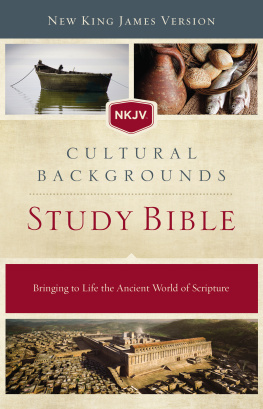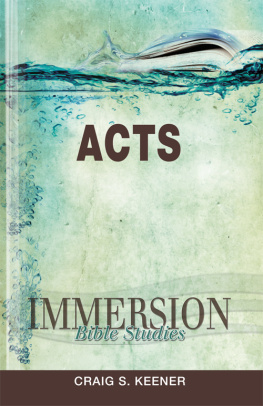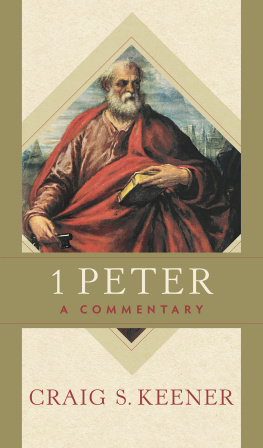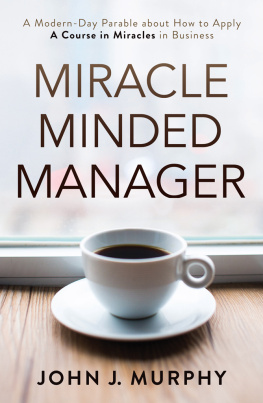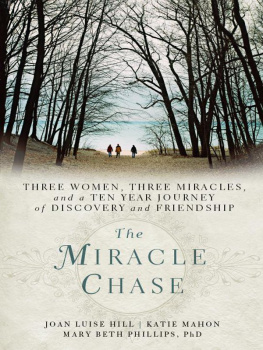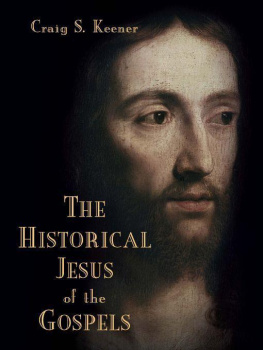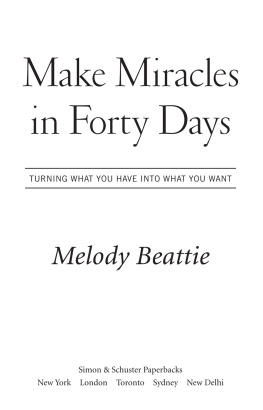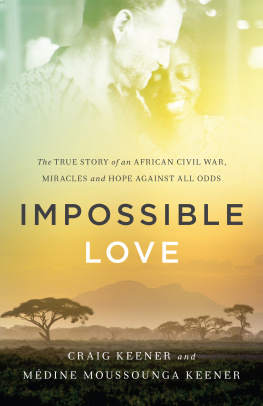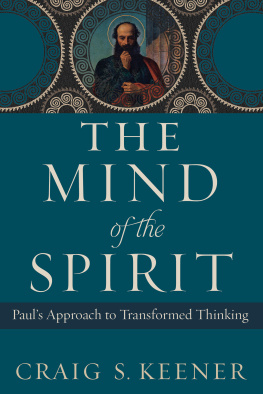Keener - Miracles: The Credibility of the New Testament Accounts
Here you can read online Keener - Miracles: The Credibility of the New Testament Accounts full text of the book (entire story) in english for free. Download pdf and epub, get meaning, cover and reviews about this ebook. year: 2011, publisher: Baker Books, genre: Science. Description of the work, (preface) as well as reviews are available. Best literature library LitArk.com created for fans of good reading and offers a wide selection of genres:
Romance novel
Science fiction
Adventure
Detective
Science
History
Home and family
Prose
Art
Politics
Computer
Non-fiction
Religion
Business
Children
Humor
Choose a favorite category and find really read worthwhile books. Enjoy immersion in the world of imagination, feel the emotions of the characters or learn something new for yourself, make an fascinating discovery.

Miracles: The Credibility of the New Testament Accounts: summary, description and annotation
We offer to read an annotation, description, summary or preface (depends on what the author of the book "Miracles: The Credibility of the New Testament Accounts" wrote himself). If you haven't found the necessary information about the book — write in the comments, we will try to find it.
Most modern prejudice against biblical miracle reports depends on David Humes argument that uniform human experience precluded miracles. Yet current research shows that human experience is far from uniform. In fact, hundreds of millions of people today claim to have experienced miracles. New Testament scholar Craig Keener argues that it is time to rethink Humes argument in light of the contemporary evidence available to us. This wide-ranging and meticulously researched two-volume study presents the most thorough current defense of the credibility of the miracle reports in the Gospels and Acts. Drawing on claims from a range of global cultures and taking a multidisciplinary approach to the topic, Keener suggests that many miracle accounts throughout history and from contemporary times are best explained as genuine divine acts, lending credence to the biblical miracle reports.
From the Inside FlapMost modern prejudice against biblical miracle reports depends on David Humes argument that uniform human experience precluded miracles. Yet current research shows that human experience is far from uniform. In fact, hundreds of millions of people today claim to have experienced miracles. In this wide-ranging and meticulously researched study, Craig Keener argues that it is time to rethink Humes argument in light of the contemporary evidence available to us.
Seldom does a book take ones breath away, but Keeners magisterial Miracles is such a book. It is an extremely sophisticated, completely thorough treatment of its subject matter and, in my opinion, it is now the best text available on the topic. The uniqueness of Keeners treatment lies in his location of the biblical miracles in the trajectory of ongoing, documented miracles in the name of Jesus and His kingdom throughout church history, up to and including the present. From now on, no one who deals with the credibility of biblical miracles can do so responsibly without interacting with this book.
--J. P. Moreland, Talbot School of Theology, Biola University
An exhaustive treatment of the subject, encompassing a range of sources from antiquity to contemporary times, from the Bible to modern Africa. It brilliantly serves not only biblical scholars but also--equally important--mission thinkers and practitioners.
--Wonsuk Ma, Oxford Centre for Mission Studies
From the very beginning of the modern approach to the Gospels, the question of miracles brought controversy. Over the last few centuries, most historical-critical scholars have dismissed them out of hand. However, in recent years, the tide has turned for a growing number of Gospel scholars. It is within this context that Craig Keeners new two-volume work can be fully appreciated. Those familiar with Keeners past volumes will not be surprised by the remarkable level of scholarship in this work. The depth and breadth of research is stunning. The interdisciplinary synthesis is as careful as it is brilliant. The arguments are evenhanded and nuanced. In short, this work takes scholarship on miracles to a new level of sophistication and depth. A truly amazing set of books.
--Paul Rhodes Eddy, Bethel University
This book is the kind of performance that reviewers of opera like to call bravura or virtuoso and that philosophers call a tour de force. After putting it down, Im standing up, clapping, and shouting, Bravo! Bravo!
--Leonard Sweet, Drew University; George Fox University
Craig Keener has produced an impressive work that is meticulously researched, ambitious in historic and geographic scope, and relevant to current cultural concerns. Keeners bold exploration of the plausibility of past and present miracle claims should provoke interest--and debate--among a wide range of readers.
--Candy Gunther Brown, Indiana University
Perhaps the best book ever written on miracles
Any history of the rise and growth of Christianity that fails to take account of the belief in miracles and healings and signs and wonders is missing a very large part of the story. That statement is truer than ever today when we look at the booming churches of Africa and Asia. Craig Keeners Miracles is thus a major contribution to understanding the Christian faith, past and present. The book is all the more valuable because of Keeners thoughtful and bold analysis of the scientific method and the means by which we can test the miraculous. This massively researched study is both learned and provocative.
--Philip Jenkins, Pennsylvania State University
Craig Keeners discussion of New Testament miracles adduces a uniquely--indeed staggeringly--extensive collection of comparative material. That eyewitnesses frequently testify to miraculous healings and other extranormal events is demonstrated beyond doubt. Keener mounts a very strong challenge to the methodological skepticism about the miraculous to which so many New Testament scholars are still committed. It turns out to be an ethnocentric prejudice of modern Western intellectuals. So whos afraid of David Hume now?
--Richard Bauckham, St. Andrews University; Ridley Hall, Cambridge
Keener deals not just with the biblical evidence for miracles but also with the vast evidence from all over the world that miracles of various sorts happen. He shows that whatever the merits of Humes claim in his own day, it can hardly be maintained today that miracles are not a part of normal experience and are not widely attested. This book is a rarity in the scholarly world in that it is both rigorous in its scholarship and speaks with knowledge and passion about an exciting subject that demands our attention. We have here perhaps the best book ever written on miracles in this or any age. Highly recommended.
--Ben Witherington III, Asbury Theological Seminary
Craig Keeners magisterial two-volume study of miracles is an astounding accomplishment. The book covers far more than the subtitle implies, because Keener places the debate over the biblical miracles in many different contexts, including the philosophical debate over miracles, views of miracles in the ancient world, contemporary evidence for miracles, and the relationship of the issue to science. Although this book is clearly the product of immense learning and a mind at home in many disciplines, it is clearly written and argued and shows good sense throughout.
--C. Stephen Evans, Baylor University
This is vintage Keener--exhaustive research, expert command of and thoughtful interaction with both ancient and modern sources, impeccable analyses of all sides of the argument, and deft handling of the controversial issues--plus some! It will undoubtedly henceforth be the first stop for all serious researchers on this topic.
--Amos Yong, Regent University School of Divinity
This monumental study combines historical inquiry into late antiquity, philosophical and existential criticism of antisupernaturalism and the legacy of David Humes epistemological skepticism, and ethnographic study of the phenomenon of the miraculous throughout the Majority World. The result is a book that is important not only for the historical study of Jesus and the New Testament but also for our understanding of our contemporary world beyond the boundaries of our social location and its worldview.
--David A. deSilva, Ashland Theological Seminary
Craig Keener has written arguably the best book ever on the subject of miracles. He places the miracles of Jesus and his followers in a full and rich context that includes philosophy, history, theology, exegesis, comparative religion, cultural anthropology, and firsthand observation and testimony. There is nothing like it. Keeners monumental work shifts the burden of proof heavily onto skeptics. This book is must-reading for all who are interested in the truly big questions of our day.
--Craig A. Evans, Acadia Divinity College
In an age of a global church, the time has come for Bible scholarship to be enriched by considering the way Christians read and understand Scripture in non-Western countries and cultures. In Miracles, Craig Keener offers an invaluable example of how that enrichment can take place through hard scholarly work and a passion for integrity. He gives us an exhaustive wealth of historical understanding, anthropological richness, and missiological savvy.
--Samuel Escobar, Palmer Theological Seminary; Theological Seminary of the Spanish Baptist Union, Madrid
Keener: author's other books
Who wrote Miracles: The Credibility of the New Testament Accounts? Find out the surname, the name of the author of the book and a list of all author's works by series.


